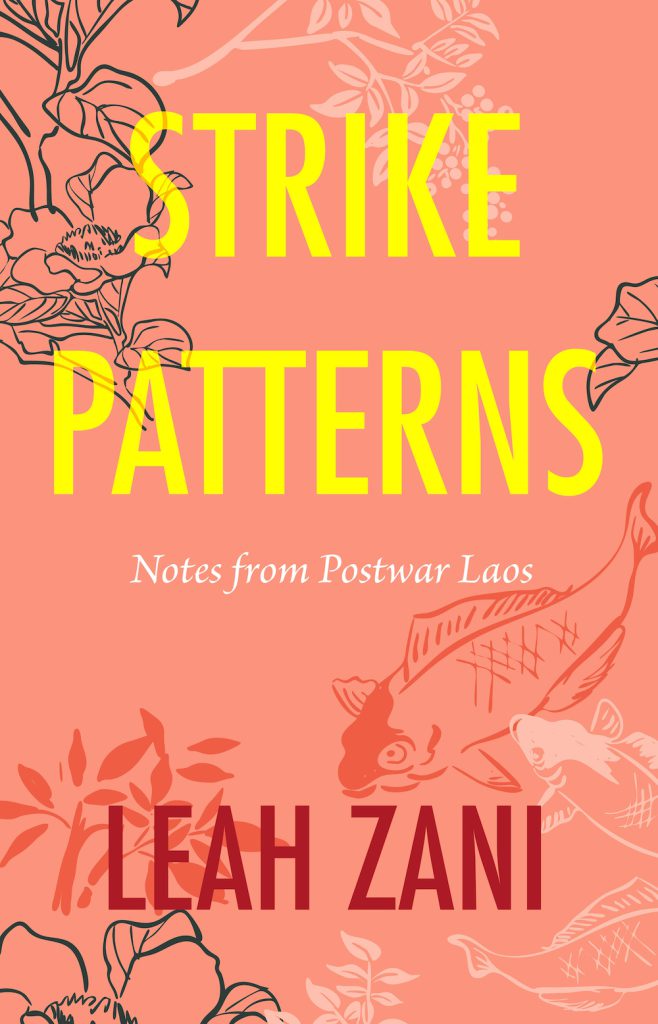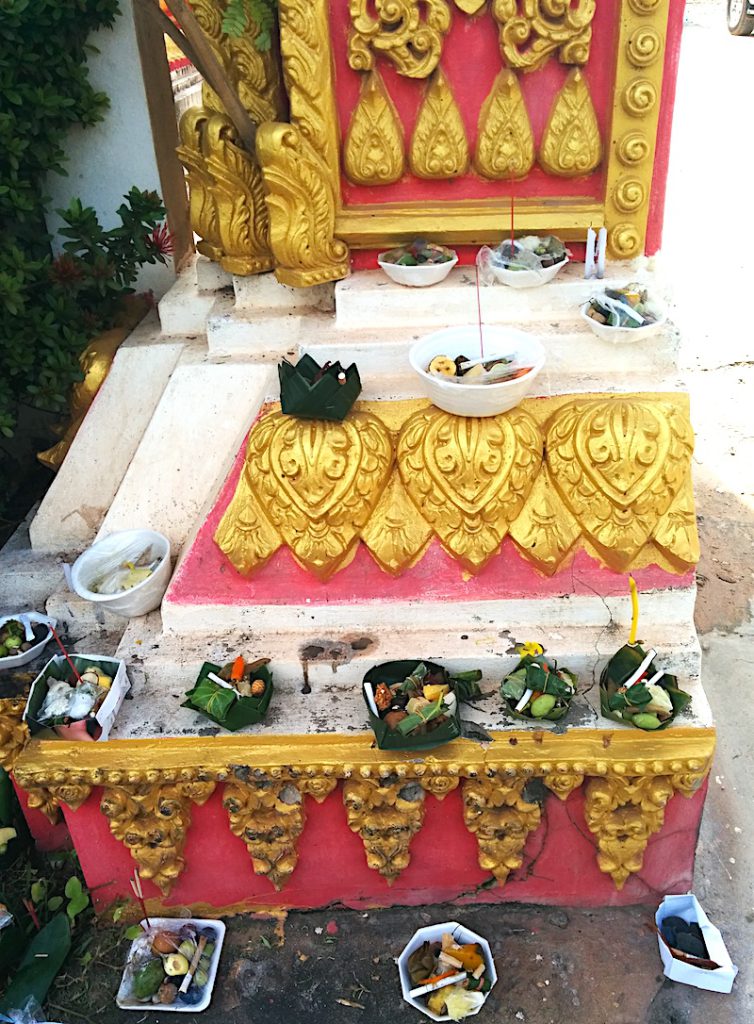Haunted by a Secret War

Excerpted from Strike Patterns: Notes From Postwar Laos by Leah Zani, published by Redwood Press, © 2022 by Leah Zani. All rights reserved.
The ethnographic novel Strike Patterns tells the story of life in a Lao river community, and of the relationships I formed as part of my research with this community. A strike pattern is a signature of violence carved into the land—bomb craters or fragments of explosives left behind, forgotten. In much of Laos, people live alongside such relics of a secret war.
From 1964 to 1973, the United States carried out a covert air war against Laos. Frequently overshadowed by the war with Vietnam, the Secret War was the longest and most intense air war in history. Most of the country remains contaminated with dangerous leftover explosives.
I use ethnographic fiction, poetry, and memoir to investigate the unreality of this secret violence—a war that remains an open secret, even as bombs continue to explode. This book is the result of 10 years of careful research and writing on war and its cultural impacts in Laos and the United States. Taken together, these are stories about the power of building new lives in the ruins.
The following draws from the fifth chapter of the book as the narrator (a fictional version of myself) travels with Vanida, an explosives clearance expert, to a neglected guesthouse in a remote highland village. They are there to get bombs out of the ground before they explode, but it is not only the bombs that Vanida and the narrator are worried about.
I told Vanida that there was a strange pattern on the wood of the door to our hotel bedroom. When I first saw it, I thought—it was a face! Wood whorls, tight as a fingerprint.
I pointed the shape out to her. It was on the back of the bedroom door, visible from the beds if we had the door closed.
“Does this look like a face to you?”
She looked at me, no expression, and didn’t look at the door.
“I think it’s a face,” I repeated, assuming she hadn’t understood.
She was still silent, almost ignoring me.
“What is it, Vanida?”
“Come on, I’ll tell you outside.”
She hesitated at the back door, then turned and grabbed a package of incense, and went out. I followed her to the outdoor kitchen and not the rose garden. All around us was the thick sound of early evening crickets. Felt-winged moths flapped shadows around the kitchen’s single bulb.
I was a few steps behind her when she turned and stopped, quickly, and nearly ran into me. Her free hand gripped my forearm, perhaps to steady herself. She leaned even closer, so close that she was lost in my shadow: “We must be careful what we say in the house.”
I resisted the urge to glance at the house, as if it were listening. Even the bugs were waiting. I leaned back slightly to bring some space and light between the two of us. “What do you mean?”
“There is a ghost in the house,” she said and took her hand off my arm.
“That’s the face, you mean.”
She nodded.
“Who is it?”
“A Frenchwoman. I do not know her name. The woman who built the house.”
“This was back before the American War.”
“Yeah, she’s an old ghost. This used to be the house of a French colonial administrator.”
“Is she a hungry ghost?” I asked with more concern. Hungry ghosts are ravenous, angry beings who harass the living out of revenge for their wrongful deaths and denied funeral rites. A lot of war dead are hungry ghosts because their bodies were never recovered for proper funerals. Hungry ghosts are skeleton thin, gray skinned. They have tiny, puckered mouths and bloated stomachs—cut off from the offerings of their living kin, they can never fully feed themselves and are often unable to move on to another life. They are made vicious by their appetites.
The names or words that a society has silenced still speak themselves in the mouths of ghosts.
“No … she’s just French.” I didn’t know what that meant, but I had a sense of neighborly strangeness. “It’s OK if foreigners stay in the guest house, so we thought it would be OK if you stayed here … but then I worried that you probably shouldn’t be in a house with a ghost by yourself.”
“Thanks for staying with me, Vanida.”
She met my half-smile with half of her own. “It’s OK, but I think it is better if we are here together. We should have told you about it, instead of letting you stay at the guest house like the other foreigners. I’m sorry. You must be careful what you say around ghosts: if you say bad things, if you say car crash, she might hear you and make it happen out of spite. She could hurt you if she wanted to.”
I let that fear slide past me.
I didn’t believe in ghosts in the existential sense of an afterlife, but I did believe in their cultural reality and ability to affect people’s experiences. In the study of culture, ghosts are real in every way that matters. This was especially true in this old battlefield: ruins layered beneath everyday life, and there was a very real sense in which people were being haunted by histories of imperialism and war. I understand ghosts as ways that violent, unresolved pasts manifest in society like unconscious thoughts in the mind. The names or words that a society has silenced still speak themselves in the mouths of ghosts.
I remembered sitting with my friend Chantha on the porch of her apartment in Vientiane. The city was under curfew: It was common to see armed men on patrol or at checkpoints. She had looked up and down the street, scanning for police and military men. Then she had pointed at the trees above us and said, “Be careful! In Laos, even the trees have tongues.” Large, thick-barked trees overhung her porch. Their long, sinuous, green seedpods were called lin mai in Lao, literally “tree tongues.” Police harassment, spies, surveillance, corruption, and extrajudicial violence like disappearances, reeducation centers, and secret prisons were an expected feature of Lao society. Many of these terror techniques had been practiced by the French colonialists or were later brought into Laos by American paramilitary trainers during the Secret War. Laos’ history of imperial warfare and more recent authoritarian violence are twin ghosts: They are both forms of state terror, methods of haunting a population through fear and force. Imagine if the trees were listening to us.
Another thought occurred to me. “Is that why you bought incense yesterday at the market?”
“Yes, I plan on using them for prayer.”
She pulled three sticks of incense out of the package, still gripped in her hand. “Will you help me place these by the front door?”
“Sure. Do we need to light them first?”
“Yes, but I am not a monk,” she demurred. “I think it is enough for us to just pray.”
Vanida thought it best for us to place our incense by the first step of the front porch stairs. And to feed the ghost, she laid out a bowl of sticky rice and a little of the fried crickets. I followed her lead: We nodded our heads in silence for a few minutes. I thought about Laos’ history of colonialism without precisely praying. At my feet, the small embers were like tiny fireflies, and the blue smoke of the incense mixed with the cool breath of night through the garden.
I first learned about the appetites of ghosts from Chantha. Back in Vientiane, she had invited me to her neighborhood wat for Boun Haw Khao Padapdin, a festival for feeding the spirits of the dead.
Chantha described the festival to me this way: “After you die, if you did bad things, there is a place like a large house where you go. Each room is a different bad thing: There is a room for adultery, a room for robbery, a room for other things. On this day, all the doors of the house are open. And every spirit can come out and eat.”
“Actually, that sounds terrifying!” I told her. I imagined hordes of specters just out of sight, waiting to pounce and devour me.
“Yes, that is because your culture is bad about feeding ghosts, so yours are very hungry. So, you are afraid of ghosts.” Chantha scooped coconut sweets onto ovals of banana leaf, laying the leaf platters among the roots of a sacred tree growing on the temple grounds. For each platter, she unscrewed the cap from a water bottle, presumably so the ghosts wouldn’t have to struggle with disembodied hand coordination, poured a first sip for the spirits of the earth, and then laid the uncapped bottles by the coconut sweets. “In Laos, we are compassionate with our ghosts.”
Chantha hadn’t told me to bring food to feed my own ghosts—I wondered where mine resided, if they were present at all—and I felt a bit like an empty-handed guest at a potluck. As if she sensed this, Chantha handed me the basket of coconut rice and the scoop. She gestured for me to help her lay out the platters.
“By being here today, you are making offerings to the very first spirits of your family. It is good that you are American.”
“What do you mean?”
“Because Americans have many ghosts to feed.”
Riding my bike home, the route back to my house was lined with offerings of fruit, rice, pastries, and cigarettes. I saw the city anew: The locations of ghosts were visible, and there were at least as many ghosts as there were living humans. Trees, electricity poles, shops, houses all seemed to have ghosts to be fed. All at once, I realized that it was a city shared among the living and dead.
At the guest house, Vanida and I were eating in the attached outdoor kitchen under the halo of the single bare bulb.
“So, what do you know about the ghost, Vanida? Who was she when she was alive?”
This was a common way to exorcise ghosts in Laos: uncover their histories, acknowledge the violence that had been done to them, and tie up their loose ends if they had any. If ghosts were real, I thought, then maybe it would mean something for me to know her story.
Vanida tittered, unusually cautious, and put her napkin over her mouth. She whispered to me under her hand: “Careful, the ghost is listening!”
“But we’re not in the house.” I could sense the large, open sky above us and the night tumbling down the mountain into the valley below.
She loosened a bit, clearly still apprehensive, stirred her stew with her spoon, and then ate a few bites. We had made sticky rice and a green eggplant stew with ginger.
“I hear that she was murdered by her husband, the French administrator.”
“So, that’s why she’s stuck in Laos,” I said, leaning back in my chair. “She died here, but her family all went back to France?”
“Exactly. French women move with their husbands. She’s far away from home.” She patted her mouth with her napkin and then refolded it back into a square in her lap.
“Are ghosts dangerous?”
“It depends. They’re like snakes in the grass. You have to be careful because they’re always listening, they’re always there even if you can’t see them.”
I joked: “Well, maybe she’s listening to us now.”
And then the lightbulb went out, spooking us both into silence.
This excerpt has been edited slightly for length, clarity, and style.































